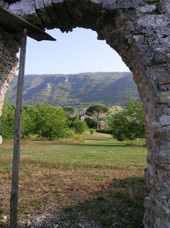In AD 144-5, at the age of 23, Marcus Aurelius travelled from Rome to the imperial villa at Villa Magna where his adoptive father Antoninus Pius awaited him. In letters to his tutor, Fronto, he described two days spent there, hunting, writing and harvesting the grapes. (Fronto iv. 5). The site of the villa where this rural idyll took place is known today as Villamagna and lies just south of Anagni, some 40 miles south of Rome, at the foot of a steep hill that must be the one referred to in the text. Covering dozens of hectares, the site of the villa today shows little of its former splendour; at the close of the 5-year physical excavation project, 2006-2010, excavated remains mostly had to be backfilled. The excavation was sponsored jointly by the Soprintendenza di Lazio, The Penn Museum, and the British School in Rome; it was directed by Lisa Fentress, with co-directors Sandra Gatti (SBAL) and Andrew Wallace-Hadrill (BSR); Associate Directors were Brian Rose and Ann Kuttner of Penn, with Field Directors Caroline Goodson and Marco Maiuro. Core funding was supplied by the 1984 Foundation, the Comune of Anagni, and the BancAnagni Credito Cooperativo.

The excavation of Villamagna aimed to study its occupation over the longue durée.The lack of deep ploughing guaranteed exceptional preservation of many of the ancient structures, giving a unique opportunity to investigate the architecture and decorative aspects of an imperial villa. Paleobotanical and osteological research threw light both onto the landscapes of the site as well as the economy of the villa and its successor settlements. At outset the remains consisted of three ranges of cisterns fed by an aqueduct which probably leads from a spring at the base of the wooded hill, a nineteenth-century casale built on top of a range of substructures which form the basis villae for a part of the ancient villa, and various traces of substructures on the long ridge running down from the casale towards the road. Halfway along this ridge is a complex of medieval structures, including the church of San Pietro with a Romanesque apse and masonry of much earlier periods, a structure which received attention in the Renaissance and early modern period and some late medieval walls; here, in the early Renaissance period were laid down a large cemetery and burials within the church. The area yielded good traces of Imperial and Late Roman occupation. The monastery that occupied the center of the ridge is particularly interesting for the study of the implantation of monasticism on classical sites, and the development of a small rural monastery from the early middle ages through the fifteenth century. The area by the casale emerged as a distinctive Imperial-era quarter within the estate whose most exceptional feature was fine banquet hall consisting in a wine-press room with sunken dolia and with luxurious opus sectile colored marble flooring and wall revetments (whose remains survived as copious fragments) in a zone largely abandoned by some point in the 3rd c. CE. Down the road from the casale was revealed a utilitarian quarter still in use in the 4th c. CE, whose Imperial-era remains are interpreted as including a slave or servant quarter. Further away down and under fields today geomagnetic prospecting revealed a very large palace complex, yet to be explored.
The result of the project is a full scientific publication by the British School at Rome (in press in 2015), consisting in a volume of analytic essays in conjunction with a dedicated publicly searchable web site housing the full site database.
Site reports are stored at the entry for S. Pietro in Villamagna at FastiOnline (a project of the International Association of Classical Archaeology (AIAC) and the Center for the Study of Ancient Italy (CSAI) of the University of Texas Austin.
